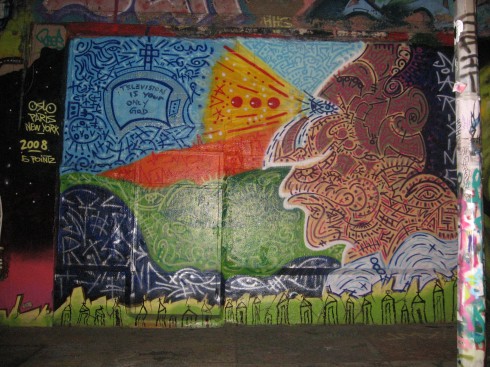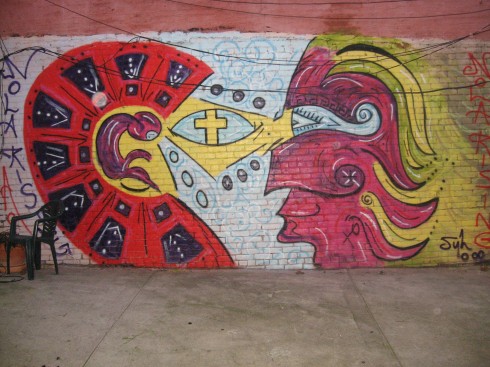Final Project Links
Third Video: NoLA Rising Paints New York
Second Video: Per Scholas A Bridge for the Digital Divide
First Video: Tackling Technophobia, Ida Harris and OATS
Five Points
“Five-points,” as it is known to grafitti artists around the world, is a large factory in Long Island City where it is legal to spray paint the walls. The owners of the factory allow artists to paint the walls as long as they seek permission first. The building, which fills an entire square block is covered from the ground up mostly in “wild style” grafitti – much different from NoLa Rising’s more mural-like Aztec inspired work, something Mike was initially nervous about. Mike, two other artists from New Orleans, the executive director of NoLa Rising and a photographer ventured out to Queens to tackle a large estimated 10 by 10 foot wall with spray paint cans and a ladder. I met them there while they were scouring the large dumpsters outside of the clothing factory for some left over fabric to use as scarves.
Around 3 p.m. the man who was in charge of allotting painting space led the crew to the wall they’d spend the next five hours covering with what Mike later considered his best street work ever. By 8:30 Mike and the other artists finally finished and they headed back to Manhattan for some tourist activities. Check out a picture of the final product below.

The day before, I met Mike and his fellow artists in Brooklyn at one of their friends’ house where they covered the back wall of the apartment with a depiction of the Virgin Mary and baby Jesus. The fumes of the paint and standing in the cold gave me a bad cold but the time spent getting to know the artists was worth it. Having spent time in New Orleans and falling in love with the city myself it felt great to be with people who, I felt, really represented the city’s unique, artistic and relaxed attitude about life. Below: NoLa Rising graffiti in Brooklyn
Pivoting on the Plan
“What’s Your Art?”
I did not have to search far to find my multimedia entrepreneur. I decided to interview Yvonne Latty because I thought it would be interesting to hear about what it as like to start a website and essentially teach a website at the same time. I was in Yvonne’s Reporting New York class at NYU last year and became involved with Pavement, but with little knowledge as to how it all came about. This year probably one hundred new biographies were added to the Contributors page and I wanted to know how she was handling the quantity of work handed in by eager students who she did not even know personally.
The other thing that intrigued me is that Pavement Pieces has no financial support from NYU, which I think is ridiculous. Besides LiveWire, a site that posts students work for publications to pick up and use without paying the students, Pavement is the only website that is designed to showcase student work and the entire journalism department has become involved by having students from all programs and classes submit pieces. But for some reason the powers that be will not put any money into the project. It is sad. Multimedia is so important in the industry today; reporters at publications are being forced to learn multimedia. So it is so necessary to have a really nice looking and well-run website at NYU to showcase the fact that the school’s students already can do all the stuff that reporters are being trained to do on the job. Luckily we do have that but money would help Yvonne better handle the hundreds of stories vying for a spot on the page and pay for necessary redesigns to keep up with the technology.
In the interview you can read how Yvonne has been getting feedback from universities all over the country. Pavement is something new and exciting to people outside of NYU and to interests beyond students’ in getting their work published somewhere that friends and family can read and see it. This is because Yvonne is one of the first professors to completely embrace multimedia and communicate to her students how important it is.
Last year in class every time any student would pitch a story Yvonne would listen and always ask “what’s your art?” It was a subtle question but one that most of us didn’t think of. Most of us thought we came to journalism school to learn to write – but we all learned much more. Today I can’t think of a story without thinking of at least a photograph to go with it, if not a slideshow. Most of the time I think about the multimedia before I think about the actual written story. She changed my thinking and helped me get to a point where I feel I have good, marketable multimedia skills that will help me in the challenging economy and job search I have recently begun.
Q & A with Multimedia Entrepreneur Yvonne Latty
Yvonne Latty is an author and an NYU professor who runs the graduate student website Pavement Pieces and directs NYU’s Urban Journalism Workshop. She is also someone who I consider a mentor and a friend. Yvonne worked for 13 years at the Philadelphia Daily News and has published two books on war veterans. Her latest book, In Conflict, adapted for the stage and performed by Temple University students, just wrapped up a successful run at the Culture Project Theater in New York City.
Yvonne is a special kind of multimedia entrepreneur because she started her own multimedia website and spear-headed NYU’s first program to make multimedia a key component, Reporting New York City. She now heads the Reporting the Nation program where she continues to emphasis and, some may say, lovingly force, her students to create as much multimedia as they physically can. Pavement Pieces has run over 1000 pieces over the last year from students from all of the school’s journalism programs including a few undergraduates. She runs the site herself with the help of an adjunct and current and former students who are willing to help from time to time.
As a former student of Yvonne’s I can write that she is truly the biggest “multimedia enthusiast” that I know. For the last two years she has emphasized how important the ability to tell stories through different media is for the future of the business, how it takes a lot work, but how the process can be fun and rewarding. I interviewed her to learn more about the start of Pavement Pieces and how she was able to make it so successful. Below: a photo of Yvonne Latty.
What was your first experience with multimedia?
Around 2004 I was working at the Philly Daily News and I wrote an obituary about a woman who was a singer in 1930s and 40s. I asked her daughter if she had any of her mom’s music and could she make it digital, and she did. She emailed it to me and put it online and it was the coolest thing ever because the obituary was her whole life story and she was this big singer in the 1930s so readers could hear her sing. At that point the newspaper had a website but it was just stories and photographs, we weren’t doing much so there weren’t any slideshows, audio or visual.
Were you involved in multimedia in any other way around that time?
I started a website for my first book and it had a few elements of multimedia on it but things were still really, really static back then. You’d get stories and then the paper had like a nerd doing the uploading stuff, but there wasn’t much creativity with the web in the early part of the century. I started realizing the magic of the web right before I started working at NYU in 2006. Things were moving to websites more and more.
Where did your interest in multimedia come from?
I love teaching it because I have a degree in film and my first love was things that move. My first book became a photo exhibit and a lot of things I write have motion in the text, that’s sort of the beat of my text. In my first semester at NYU I was like ‘I want to do a website and experiment.’ I felt like it’d be so perfect to do it in the classroom and for my students to lead with what was coming out of their own heads. I just wanted them to go out and do it, not be like, ‘This is what the New York Times does’ and just copy what others do. I wanted the website to be hip and funky and cover New York, I also wanted it to serve underserved communities and the stories that weren’t being told. I was inspired by the stories my students started doing. They were going into the South Bronx and all these neighborhoods. With my career I’ve been doing multimedia because I’ve always taken photographs and I already had all the elements I needed to be a multimedia reporter and I am not scared. For me, you cannot be afraid of failing, you have got to go up and you gotta swing.
What has been the biggest challenge about running Pavement?
Probably the biggest challenge is working the CMS, or the platform you are working in. I have no financial support for Pavement so a lot of it is run on the passion of me and my students. You know multimedia is constantly changing and on of the biggest problems is that I want to change with it. So it’s kind of frustrating to always do that.
So how does it work then?
It has a lot of energy behind it so that’s why I feel like the stories seem to fly off the page. It runs on love.
Did you have any examples to lead off of?
I have no role model. There is no one that I can look at and say, ‘look! That is what they are doing and that is what I want to do.’ If anything, my role models are my students. If I learn anything it is probably from them. Columbia has a website called brooklynink.com. But Pavement is a lot broader in scope. A lot of schools do websites but they focus like just on the Bronx, or on an issue- it’s a one shot deal and that is it. It is like the whole website is just what Pavement’s immigration piece was last year – a look at one issue in different ways.
Explain the kinds of pieces Pavement has?
Right now we have stories from all over the country and in terms of New York we have stories from all diff neighborhoods. We do stuff from methadone clinics to prostitution to poverty and in a way that makes it more complex.
What did you first envision for Pavement?
When I first started it I really thought it was just going to stay with my class and we wouldn’t turn it around so much. I was thinking maybe twice a semester but I’ve been really amazed by the video, audio and slideshows my students generate and how they makes this stuff. I think it is great that they all have a vision. For me as a teacher it has been so rewarding to watch my students grow. I feel that I am training leaders. They’ll be the ones to make decisions in news. You watch and see how hard people work because Pavement gives them ownership over their work.
How do you teach multimedia?
People say if you want to write you should read good writers but with multimedia it is so new and fresh for me it’s like ‘what’s your idea? What do you think?’ And it’s a really interesting way to teach something. That is what is exciting about multimedia for me, that it is new and fresh and outside of new boundaries. Which is why it is really challenging to run a website on no money. It runs on love, I love it. I’ve done a lot of professional stuff in my life and Pavement is one of my most cherished professional successes.
What kind of feedback do you get on the site and from where?
I’ve had universitites form all over the country ask me how they can start their own Pavement Pieces. I’ve had people from newspapers asking how I am even getting my students to do some of these stories. They ask ‘what is going on in Reporting New York and Reporting the Nation? Can you tell me how you do this?’ I think that other places like Columbia have all similar stuff to what you see on the New York Times. There were so many great pieces from my Reporting New York class last year. One student got a woman talking about torture camps in Burma and how her blood was taken from her. Just really incredible stuff. There is a real honesty in the students’ work and that is what we all strive to do as journalists. After the election this year I had students send emails to thank me for Pavement and putting their pieces up. They like to see their stuff up there and it inspires them to keep growing.
What do you need to make it in the media today?
You have to be inspired and bring something else to the table. The industry is always in flux and you never know where stuff will land. The struggle now with people in the business is that they want to learn new tricks to make it. The hard thing about multimedia is that it doesn’t make money the way newspaper does. In a way people are reading more than ever but the business is making no money.
Tell me about your Urban Journalism Workshop that ran this summer?
It was already a program at NYU but it used to be just newspaper. So we went crazy and had them do audio, video and slideshows – the whole thing. We used the Washington Square News’ Macs, iMovie, Garage Band, little Canon cameras and I raised money to by some Edirol recorders. When we have really nice sound on videos and slideshows it really pushes things up another notch. The UJW was a really amazing experience because I as a city kid and it was a great way to teach them to immerse themselves in journalism. If you want to be an effective story teller you are going to need to know how to tell stories on different platforms. The best way not to be scared is to start young. I was amazed by how well they did, it was very inspiring.
Did you run into any problems with the workshop?
A lot. When I took it over there was no money, if anything we were at a deficit. Me and the other person running it raised $30,000 in four months. We wrote letters, I begged, proposals and called people and tried to sell the vision of mostly minority urban kids telling stories on different formats and falling in love with journalism, being inspired by journalism.
Do you feel there is a need to increase minority presence in news?
Yes. There is not a large minority presense in journalism and the cuts are effecting minorities because they are usually the last hired. It is difficult to be in a news room and be the only one of color. New York is such an incredibly diverse city and it’d be nice if some of the people covering it were the same as the people they covered. Programs like UJW can help bridge that gap. And we have to get them in the business of teaching in universities too.
What do you think the future of multimedia is in these hard times?
I love multimedia. It keeps me going, it is challenging, wide open. All the talents I have- being a photographer, making films – they have all converged. My website has multimedia for my play – I do a lot myself now. I like to experiment a lot with audio these days. While some people are depressed I find a lot of excitement in it.
What are you working on in your program right now?
We are working on a big AIDS package that I am excited about. It is working out really great and next semester we have the inauguration.
How did you manage to even create Pavement with no money?
I used all my research money to hire a web designer to design it for me. He is a really young hp designer and really cool. He did a favor and created the possibility for me and I just ran with it. It ended up not being functional for us because it was a HTML site and once we started and really too off – first there was a package on 9/11 and then one on the LGBT community – we needed to do a redesign and it became the graduate department. That was in October 2007 when we redesigned. So in one year we’ve published close to 1000 stories. For the election we had over 200 stories in a week and for the primaries we had 122 stories in 48 hours. We’ve been all over the country with the site, from breaking news like the Pope coming and Spitzer’s affair to really long and thoughtful pieces on immigration. And we have all different beats from Harlem to graffiti.
How do you get students to cover breaking news?
I wanted to make it like the students are part of the action and they did it. It keeps them motivated and want to keep doing it. They are hungry you know, things are moving, business is moving and I don’t know where it is heading but stuff is happening.
What is next for you?
I am going to talk at Temple University for career professionals on how to embrace the language of multimedia and I get emails all the time asking how to do it. I am also on a National Association of Hispanic Journalists committee to help journalism professionals rethink how they do their jobs.
Yes Men say Iraq War Ends
Rocketboom posted a video about the crank NY Times paper declaring the Iraq War over. On Wednesday a liberal political prank group, called the Yes Men, spent over six months preparing the fake 14-page paper dated July 4, 2009. They distributed the copies at Grand Central Terminal, Washington and Union Squares, the 14th and 23rd Street stations along Eighth Avenue, and Pacific Street in Brooklyn, among others.
A website that resembled NYTimes’ style accompanied the paper on Wednesday. Both the site and the paper contained a list of progressive websites that the Yes Men were promoting.
The Yes Men have pulled pranks like this before. You can read the list here on their site.
Multimedia Realization
I haven’t been focusing on making an entertaining video. I’ve been focusing on making a video packed with information and hoping that it would be remotely entertaining. This is why my Per Scholas video has still not been posted.
I tried to re-edit it so that it was shorter and has less information, but I ended up recording a voice over that still contained too much information about the process of refurbishing computers and didn’t convey why Per Scholas and how it goes about this process is important.
I’ve been grappling with how to make this video short, sweet, interesting and entertaining. So I’ve found some videos that I think did a good job and have learned a few things from them.
Here’s a couple:
3 minutes 22 seconds
The Times reporter started off with the most interesting thing – swinging chickens and all the kinds of people who were swinging them. Then he went in to an explanation about why chickens were swung, using very conversational voice over and then an expert on the religion and chicken swinging’s significance for that culture. He ended with another intriguing image of chicken swinging. The video was X minutes long, and simply explained something he happened to run into on the street. I am sure he could have added history and personal accounts of the importance of chicken swinging but it would have been superfluous, so he stuck with the meat of the story and it made for a great and highly entertaining.
David Pogue, 4 minutes 10 seconds, Green Players
Pogue regularly uses humor to make technology videos interesting, and I think he usually succeeds. In this video he stars himself on a trek to Greenwich, Ct. to test two new eco-friendly music players and personal devices. He breaks up the instructional sections of video by joking about his “expedition” which engages the viewer. I enjoy his style, but this is not something I see myself doing, mainly because I am too shy. I do feel that I need to try to inject some humor into my videos in some way however.
While it is too late to probably make my Per Scholas video very funny, I can definitely cut it down and fix my voiceover so that I get quickly to the point in a conversational manner, rather than just read a paragraph of information. Hope to have that up next week!
White Space Opens
The next Broadway play you go see may sound a little more cracklier than you would like now that the white space used by wireless microphones will be opened up to big companies like Google and Verizon.
The fight for the white has ended and the communication tycoons have made a big win. White space will now be opened up for dozens of yet-to-be invented technical communication gadgets (proponents of the ruling argued that the freeing of the white would promote innovative technology similar to the way Wi-Fi did.
Google, Verizon, and other telecommunications companies launched a massive lobbying campaign to push the FCC to vote for the proposal. Dolly Parton, rock musicians, federal sports leagues, Las Vegas casinos, Broadway groups and others have fought to keep the space unused, worried about interference. But studies conducted by the FCC since 2004 claim that interference can be avoided by applying strict usage rules.
Here is what a Washington lobbyist for Google had to say:
“This could lead to Wi-Fi on steroids,” said Richard Whitt, a Washington lobbyist for Google on telecommunications issues. “It could become a ubiquitous nationwide broadband network.” The battle between the old media and new media companies is a byproduct of an impending change in the way over-the-air TV signals are delivered. In February, TV stations will be required to switch from analog broadcasting to digital, which is less susceptible to radio interference.”
Consumers will feel the impact of this decision, but no one really knows what the impact will be. It has the potential to raise prices because in addition to the decision on white space, the FCC has allowed a merger of spectrum between Sprint and Clearwire that will create a nationwide WiMax network and approved Verizon’s $28.1 billion deal to buy Alltel. This creates two new wireless networks backed, in part, by Google.
While a close monopoly on the communications industry could raise consumer prices, new technology that is expected to merge from the FCC vote will, most likely, introduce new ways to connect farther and more quickly than we’ve seen with WiFi.


